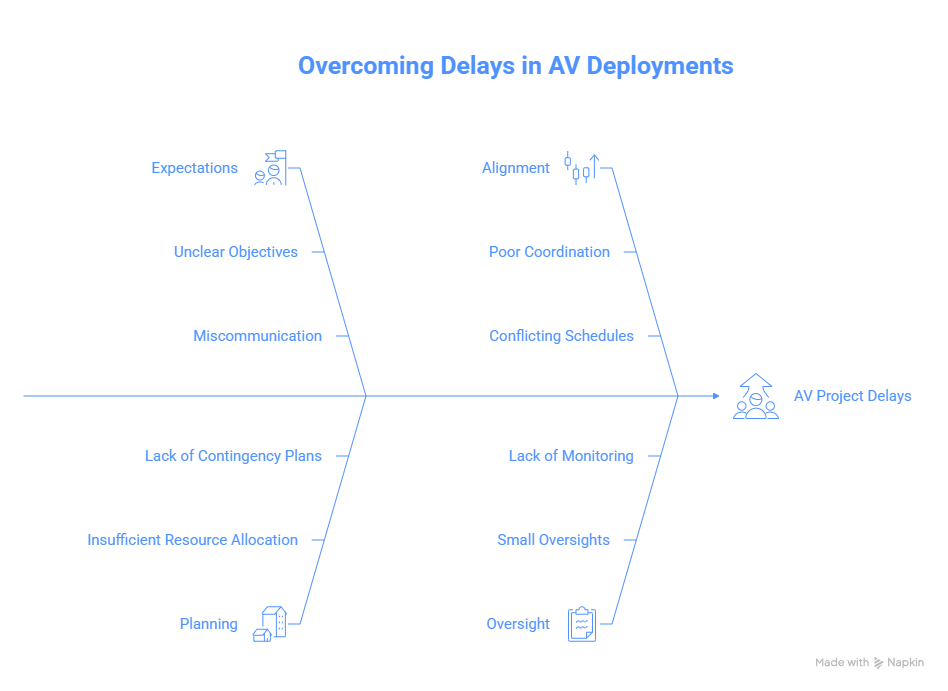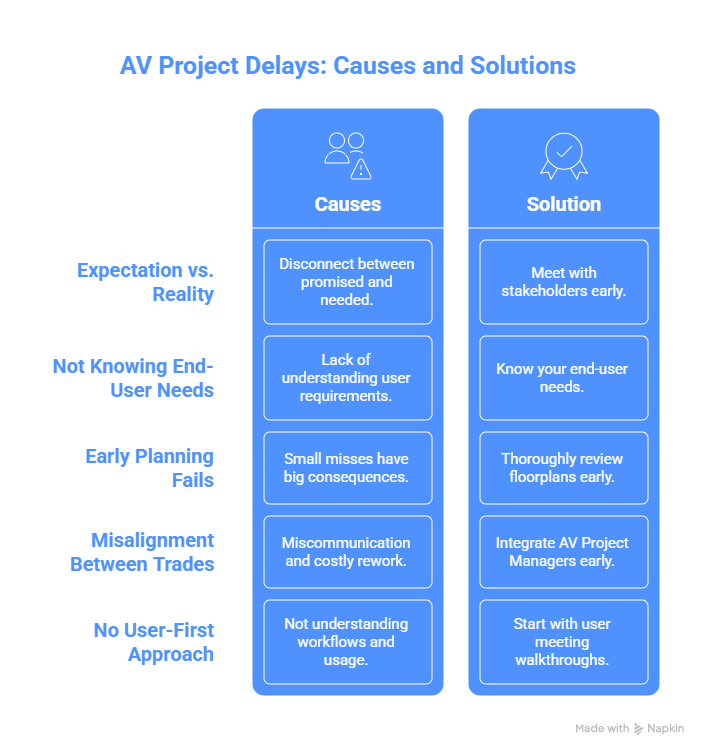5 AV Project Pitfalls That Cause Delays & How to Avoid Them
When it comes to AV deployments whether a sleek single-room upgrade or a full-scale national rollout, delays can be costly and frustrating.
Whether you're a general contractor, consultant, or IT manager overseeing AV rollouts, staying on schedule requires far more than having the right gear or implementation of few TVs and wires, it’s about expectations, planning, and alignment across all trades.
At CaTECH Systems, we’ve seen firsthand how small oversights snowball into AV project delays. We sat down with Ken Fournier, Director of Audio Visual at CaTECH, to uncover the top reasons AV projects stall and more importantly, how to keep your timelines intact.

1. Expectation vs. Reality/ What Was Specified vs. What Is Needed leading to AV project delays
Many delays stem from a disconnect between what was promised on paper and what the end user actually needs.
Often, what the end user expects and what was actually sold to them don’t align. That leads to confusion, disappointment, and last-minute changes.
For example, a client assumes their camera system will auto-track speakers and presenters when they’ve only been provided with a wide-angle camera.
We mitigate this disconnect by meeting with stakeholders well before implementation begins. We walk through the end user functionality and equipment specs in simple, clear language to ensure there are no surprises with the final results.
Ken says: “I always make it a point to go through the end user functionality of a room or space —because half the time, they come back saying, ‘This isn’t what I thought I was getting.’ We make sure they understand what’s actually being delivered before we move forward.”
2. Not knowing your end-user’s needs
Not knowing what the end-user needs is one of the most common and costly delays that arises before a single cable is even pulled.
If there’s one thing we tell our clients to prevent AV delays, it’s this: Know your end user and what they need to function properly.
Ken shares, “80% of AV success lies in solving real needs, not chasing every “nice-to-have.” Prioritize function, streamline the must-haves, and partner with a vendor who guides you through the noise.”
3. Early planning fails: Small misses often have big consequences
It might sound minor, but sometimes early planning fails, as simple as furniture placement and conduit availability, can become common culprits behind AV delays.
For instance, if a table lacks proper grommets or the ceiling types weren’t planned for AV during construction, installation is stalled, or worse, boarding and ceilings need to be opened after they have been painted and installed.
Usually, our team identifies these risks early by thoroughly reviewing floorplans and reflected ceiling plans to raise flags before site conditions become project blockers.
“If the ceiling is a different type that what the drawing says or there’s no path to pull cable to it—suddenly, we can’t do our job. It’s a small miss with big consequences," he explains.

4. Misalignment Between Trades= Project Chaos
When AV teams aren’t looped in early with electrical, construction, or IT, the result is miscommunication and costly rework.
These small misses can derail an entire timeline. We make sure that our AV Project Managers are on-site, involved from day one, and fully integrated into planning conversations.
This boots-on-ground approach reduces scope confusion and ensures every trade is on the same page.
“If the conduit isn’t in before we show up, we can’t move forward. We flag those needs early, like if the floor plan shows a floating table, we ask: ‘Is conduit in place?’—but when it’s missed, it costs the client time and money,” he adds.
5. Not having the user-first approach in design
AV is not just about mounting TVs, it’s about understanding people, workflows, and how technology supports real-world usage.
From stakeholder walkthroughs to end-user training and post-installation support, we build trust that lasts beyond handover.
Ken quips, “That’s why we start every engagement by asking: “What does your meeting look like today? Walk us through it. This user-first approach helps us design systems that work not just technically, but practically.”
Thinking of an AV project? Let’s help you avoid your AV project delays and deliver seamless and scalable results.
Read More: Top Trends in Digital AV: What Businesses Need to Know in 2025



